It’s no secret to fans of my YouTube channel that there are a lot of weeds here at Haphazard Homestead. And it’s no secret that I eat a lot of them, too! I prefer to think of my yard as a giant buffet. I just have to go out for a walk and see what’s been set out in the salad bar today. Just like any salad bar, some of the plants I use would be too much of a ‘one note song’ all by themselves. But when you mix all these notes together, the song is great!
I just go out for a walk, pick the tasty things here and there, not too much in any one place, and then make my salad. I use tender weeds, tree leaves and flowers, wildflowers, domestic flowers, wild seeds, and sometimes plants from my garden, too. I like mixing a lot of different edible plants, because the flavors all mix so well, and I get a wider variety of nutrients that way, too. I never, ever get tired of a wild salad, and they don't have to be fancy or complicated at all. The flavors are strong because it's all fresh-picked, and the flavors are complex because I mix so many kinds of plants together.
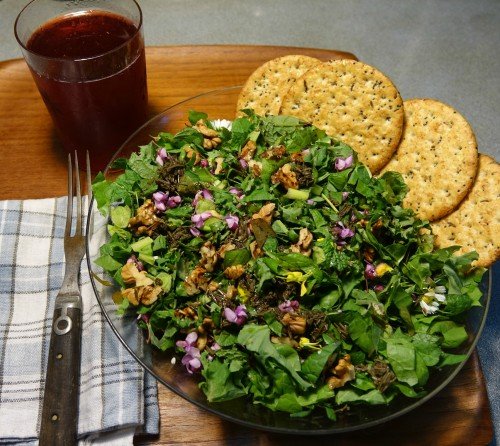
Salad from April 16 with American elm seeds, redbud flowers and young leaves, young maple leaves, dandelion greens, dock, nipplewort greens, field mustard and collard flowers and flowerbuds, English daisy flowers and leaves, wild arugula, hedge mustard, spearmint, lemon balm, small borage leaves, kale, swiss chard, green onions, field pea shoots, and homegrown English walnuts. My dressing was my own homemade spruce needle balsamic vinaigrette. This was really a great salad and went well with the juice from my homegrown, frozen red currants!
Most of these plants are not for sale in a store at any price, but I can pick all I want for free – how great is that! The pictures here are just a sample of the salads I’ve been eating this year, from mid-April to mid-May, 2016. The captions list the common names that I call these plants. I’ve also included a list of the scientific names at the end of this post, for the trees and weeds, so there isn’t any confusion about what plants I’m eating.
After I made this list, I was really surprised at all the different plants that went into these salads just in one month. They are all plants that I don’t have to mess with – they take care of themselves every year, either by being perennial or re-seeding themselves. That includes the garden plants listed, too.
I’d love to know if you eat these plants – and what other weeds, tree leaves, flowers, or seeds you put in your spring salads! Let me know in the comments below! If you want to see more posts about these plants and other wild plants that are great to eat, be sure to hit the follow button for my page!
Salad from April 24 with Elm leaves and seeds, redbud leaves and flowers, hawthorne leaves, new needle growth on Colorado Blue Spruce, Lilac flowers, Rose of Sharon leaves, dandelion leaves, dock leaves, nipplewort leaves, field mustard flowers, red clover leaves, Swiss chard, kale, spearmint, young hop leaves, borage flowers. I added raisins, raw sunflower seeds, and a balsamic vinaigrette.
Why Spring?
I can pick a wild salad almost any time of the year, but the springtime is special because the trees and shrubs are putting out their leaves and some of them are wonderful to eat. These salads change from day to day as the spring season progresses. I like eating these salads because it encourages me to pay close attention to a wide variety of plants in my yard. And it helps me appreciate all the changes that these plants are going through.
In the late winter and late summer, it can take more than 15 minutes to make a good weed salad. In the late winter, the weeds are small, but it can still be worth it to make a salad, especially if I am out wandering my yard anyway. Here in Oregon’s Willamette Valley, where we have very dry summers, by the end of that season most plants are putting their energy into seeds and roots. Once the fall rains start again, we will get a flush of new plant growth, so the salad bar will be restocked and I will be stoked! Until the rains return, I’m making 15-minute salads from my garden – including garden weeds, of course!
Salad from May 14 with field pea shoots, Swiss chard, green onions, pineapple weed flowers and leaves, wild field mustard flowers, English Daisy flowers, rose petals from a Blue Girl, and black locust tree flowers, topped with a simple balsamic vinaigrette and homegrown English walnuts. Mmm. And those pineapple weed flowers do taste like pineapples!
It's a Simple Recipe That's Not Really a Recipe
Spring moves along so fast! There can’t be any specific recipe for these salads, because the mix of what I pick is completely determined by the weather and how the plants respond. That changes from year to year. If there is a hot spell, some plants can be done in a week. If the spring is cool, I can pick from those same plants for a month. Sometimes I mix in plants from my spring garden. But I try not to add too many, because I like the taste of the wild plants.
Here’s how I put together my homestead salads.
- Grab a big bowl and a knife, and take a walk around the yard.
- Pick some of the edible plants I see. Pick clean! No sticks, grass, or other plants – just the right part of the right plants. Pick organized! Keep each kind of plant in its own place in the bowl.
- Keep moving! Try to pick 4 times more than you think you could possibly need. When 10 minutes are up, go back to the kitchen.
- Put the contents on the kitchen counter – keep the plants organized into their own little piles.
- Look over everything, to see if there is anything of poor quality or the wrong kind of plant. Look it all over again.
- Dump everything into a bowl and rinse it well with water. Drain.
- Dump everything on a cutting board and chop it up fine. I chop everything up pretty small. It helps mix the flavors and makes the salad easier to eat.
- Put it all in a big salad bowl. Top with whatever you want. I don’t use a lot of dressing on these salads, because the plants are so flavorful. My favorite salad dressing is a simple balsamic vinaigrette – I often use a balsamic vinegar that I make from spruce tree needles.
There you go! It’s a salad that will fill you up for a long time. All that chopping makes the salad really compact and dense. One big bowl is a very filling and satisfying meal!
Making a salad, April 21, with trees, including elm leaves, elm seeds, redbud leaves, hawthorne leaves, river birch leaves, crimson norway maple leaves and little seeds, western larch needles, and the first black locust flowers of the season; flowers, from lilacs, dandelions, field mustard, collards, borage, and apple blossoms; weeds, including dandelions, dock, catsear, nipplewort, and garden greens, including kale, Swiss chard, lemon balm, spearmint, field pea shoots,and hop leaves. Topped with an oil and balsamic vinegar mix, fresh-cracked black pepper, and some raisins.
Species List
Trees
- American elm – Ulmus americana – green seeds and young leaves
- Eastern redbud – Cercis canadensis flowers
- Norway maple – Acer platanoides young leaves, flowers, young seeds
- Sugar maple – Acer saccharum young leaves, flowers
- Hawthorne – Crataegus spp. leaves
- River birch – Betula nigra young leaves
- Western larch Larix occidentalis – young needles
- Black locust – Robinia pseudoacacia flowers
- Colorado blue spruce – Picea pungens young needles
- Apple – Malus domestica flower petals
- English walnut Juglans regia – nuts from previous year
Weeds
- Dandelion – Taraxacum officinale – leaves and flowers
- Dock – Rumex crispus – young leaves
- Nipplewort - Lapsana communis - leaves
- English daisy – Bellis perennis – leaves and flowers
- Wild arugula - Diplotaxis tenuifolia - leaves
- Hedge mustard – Sisymbrium officinale - leaves
- Field mustard – Brassica rapa –flowers and flowerbuds
- Cats ear - Hypochaeris radicata - leaves
- Red clover – Trifolium pretense - leaves
- Mallow - Malva neglecta - leaves
- Cleavers - Galium aparine - leaves
- Pineapple weed – Matricaria discoidea - leaves and flowers
Shrubs and Vines
- Rose of Sharon - Hibiscus syriacus – leaves
- Roses (Blue Girl) – Rosa ‘Blue Girl’ - flowers
- Lilac – Syringa vulgaris - flowers
- Hops – Humulus lupulus - young leaves
- Concord grapes – Vitis labrusca - tips of vines
Flower, Garden, and Garden Escape Artists
- Tulips – Tulipa spp. - flower petals
- Spearmint - Mentha spicata - leaves
- Borage – Borago officinalis - young leaves and flowers
- Lemon balm – Melissa officinalis - young leaves
- Field Pea – Pisum sativum - young shoots
- Kale – Brassica oleracea - leaves
- Collards – Brassica oleracea – flowers and flowerbuds
- Swiss chard – Beta vulgaris - leaves
- Green onions – Allium cepa - leaves
Making a salad on April 26, with young leaves from sugar maple, hawthorne, river birch, and Rose-of-sharon, new growth from Colorado blue spruce, Concord grape shoots, and black locust flowers; leaves from dandelions, mallow, nipplewort, cleavers and flowers from field mustard; and spearmint, lemon balm, swiss chard, kale, young hop leaves, field pea shoots, tulip petals, and borage flowers.
For More Salads
If I make a salad for more people, it takes a longer time to gather enough for everyone! But I can make a salad like this in 30 minutes for three people. I made a YouTube video that shows two giant salads using 22 different plants:
I've got some other tips for foraging and making salads from weeds, too, on my YouTube channel, Haphazard Homestead.
If you appreciate this post, I would appreciate an upvote. If you are interested in this sort of content, please follow me here on Steemit. If there is a specific plant you would like me to post about, please let me know. I'd love to hear about what wild plants you like to eat, too!
There are so many great plants out there, just waiting for us to appreciate them and make use of them. Wild plants can be real food for regular people!
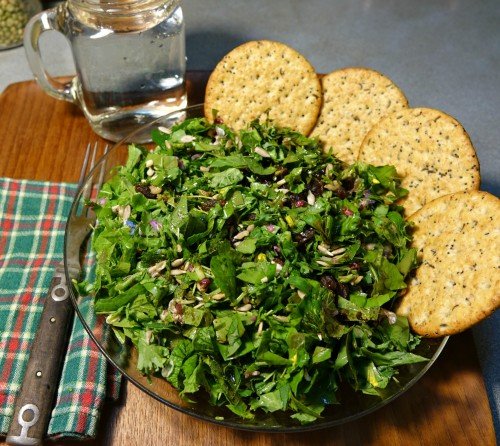
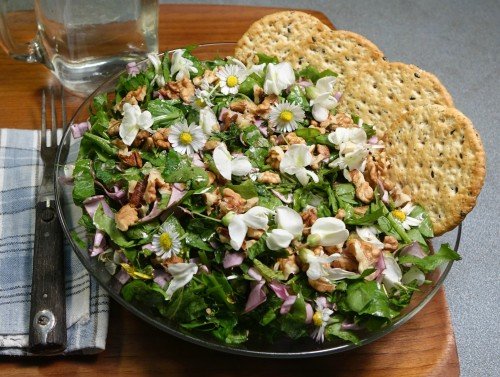
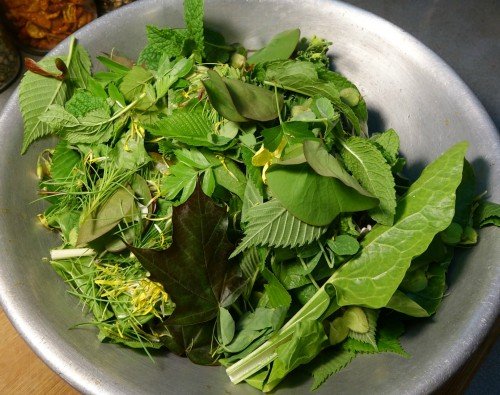
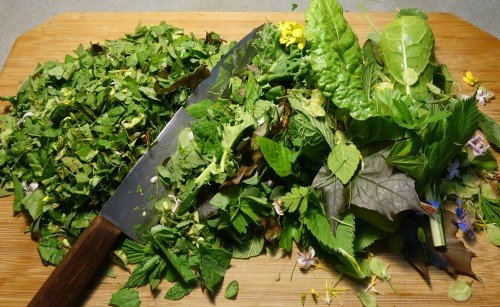
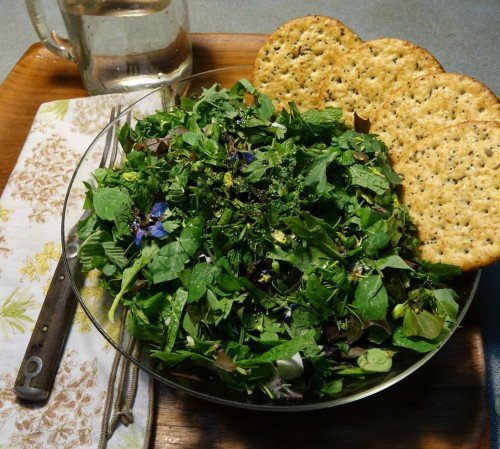
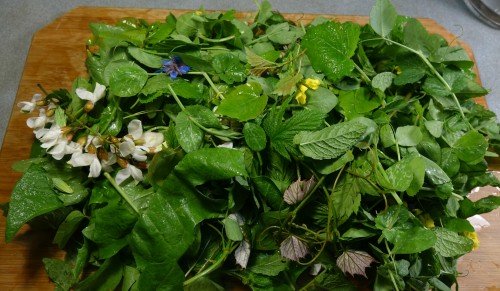
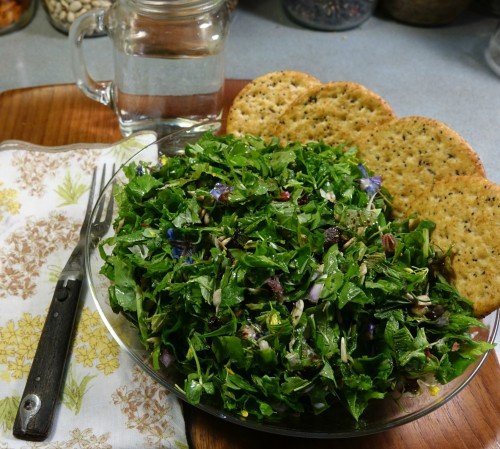
I just saw this post! I am simply Wowed with so many varieties of salads! It's amazing what the nature gives us!
Downvoting a post can decrease pending rewards and make it less visible. Common reasons:
Submit
I really enjoy my wild salads. Every one is different, but they are all so good! Cutting everything up into tiny pieces really helps mix the flavors. So many good plants out there! :D
Downvoting a post can decrease pending rewards and make it less visible. Common reasons:
Submit
This is the type of content I've been waiting for! Can you show us how you id the plants in the wild?
Downvoting a post can decrease pending rewards and make it less visible. Common reasons:
Submit
Thanks for your appreciation of my post! Helping folks get to know some of our great edible plants is one of my main reasons for being on Steemit and YouTube. I'm hoping to have some good conversations with people on Steemit about foraging and using wild plants. Is there a particular plant you are interested in?
I think the best identification videos I have on YouTube right now are for the wild field mustard, elderberry shrubs, and spruce trees. But I show a lot of other wild food plants in my other videos, too, from the tiny bittercress to the giant Deodar cedar tree! I also show how I identify a meadow mushroom, too, and decide whether to eat it or not.
Downvoting a post can decrease pending rewards and make it less visible. Common reasons:
Submit
One idea for future posts if if you link the youtube videos and give some background or additional info in the post. You could do them each one at a time, and wind up with a couple great posts.
Downvoting a post can decrease pending rewards and make it less visible. Common reasons:
Submit
Thanks for that tip, @papa-pepper. I'm trying to get the hang of things here, for sure, and I appreciate any and all helpful hints. I'm hoping to use my Steemit posts as a way to help me develop some of my future videos, too.
Downvoting a post can decrease pending rewards and make it less visible. Common reasons:
Submit
Your doing a great job so far!
Very impressed with this post as it has a LOT of information. Be sure to follow @pappa-pepper he is without a doubt an up and coming Steemit Star!
There is always more to learn and ways to improve. With practice and tuning into people doing great things you are sure to get more and more successful every day!
Downvoting a post can decrease pending rewards and make it less visible. Common reasons:
Submit
Thanks, @quinneaker! There's more than a lifetime of learning about plants, that's for sure!
I've followed @papa-pepper from the start -- I noticed him when I was looking at Steemit from the outside. His posts were key for me to sign up for Steemit. There was so much good discussion and enthusiasm for wild foods and gardening, and connecting with the outdoors.
Downvoting a post can decrease pending rewards and make it less visible. Common reasons:
Submit
Not any particular plant, I would like to see something like how many wild edibles you can find in your neighborhood. That would be really interesting to see how much free food we are overlooking!
Downvoting a post can decrease pending rewards and make it less visible. Common reasons:
Submit
Thanks for that great idea! Hoo-boy, that would be quite a list -- just for my yard! Of course, they aren't all edible at the same time. That's part of what makes eating wild plants so special -- I have to pay attention and adjust to the plants' schedules. And some of the plants take some special effort to prepare, but others I can just eat without doing much to them at all. Some are great as real food, to eat in quantity. Others are more like a spice or best as a tea to drink. I guess I better start a list! Thanks! : )
Downvoting a post can decrease pending rewards and make it less visible. Common reasons:
Submit
Yay can't wait to learn more!
Downvoting a post can decrease pending rewards and make it less visible. Common reasons:
Submit
Yes this is a very VALUABLE post!
Great to see someone with this passion here on Steemit and sharing it with this community. This is truly some of the most important knowledge that very few people have any more!
The Garden of eden @gardenofeden posts daily about wild medicinal plants, what their uses are, how to use them and how to identify them. VERY VERY valuable knowledge and very well done. Here is a link to one of the more successful posts but there is MANY!
Defiantly worth checking out and following!
https://steemit.com/gardening/@gardenofeden/wildcrafted-medicine-the-incredible-healing-properties-of-henbit
Downvoting a post can decrease pending rewards and make it less visible. Common reasons:
Submit
Thanks, @quinneaker! I already follow @gardenofeden. You make some great posts there and have a nice series about our great wild plants. I'm still working on checking out the whole series -- from you, @papa-pepper, and other folks. Happy foraging!
Downvoting a post can decrease pending rewards and make it less visible. Common reasons:
Submit
Well the post will be forever waiting there in the blockchain. ;-)>
Though its in your best interest to see em sooner than later.
Real value~*~
Downvoting a post can decrease pending rewards and make it less visible. Common reasons:
Submit
Yep, there's a lot to do!
Downvoting a post can decrease pending rewards and make it less visible. Common reasons:
Submit
OH WOW, a man after my own heart!
If only it were still spring, and you could have sprinkled the whole thing with little red bud flowers (I love doing that). Excellent entry my friend!
Downvoting a post can decrease pending rewards and make it less visible. Common reasons:
Submit
Thanks, @papa-pepper! My salads from April 16, 21, and 24 had redbud flowers and/or young leaves in them. But the blossoms dropped really early this spring. I love redbud flowers. They are a great for introducing people to wild foods because they are so pretty, so unmistakable, so abundant, and so tasty! I like them in salads, with eggs, and they are great with beans! Spring is so full of food, free for the picking!
Downvoting a post can decrease pending rewards and make it less visible. Common reasons:
Submit
I love this post! Could you please verify that the youtube video is indeed yours? Perhaps by putting a link to this Steemit post in the youtube video description?
Downvoting a post can decrease pending rewards and make it less visible. Common reasons:
Submit
Thanks! If you go to the About section on my channel, I have put a statement there that I am now posting on Steemit. I'll go add a link to this post in the video description, too.
Downvoting a post can decrease pending rewards and make it less visible. Common reasons:
Submit
I added the link to this post in the description for my YouTube video, @anwenbaumeister.
Downvoting a post can decrease pending rewards and make it less visible. Common reasons:
Submit
Great post! Upvoted and followed! Looking forward to more content from you. Maybe check out some of our stuff and consider upvoting and following. https://steemit.com/cooking/@lily-da-vine/how-i-became-a-chef-misadventures-in-the-kitchen
Downvoting a post can decrease pending rewards and make it less visible. Common reasons:
Submit
Thanks! And I'm with you -- cast iron is wonderful! You've come a long way from a non-cook to personal chef in 3 years. Congratulations!
Downvoting a post can decrease pending rewards and make it less visible. Common reasons:
Submit
Great article about an interesting subject. I've been interested in knowing how to identify the weeds, leaves, etc. that are edible because the way this old world is going, we may wind up having to forage in the wild for our own food. And wild salad fixin's are very healthy.
Downvoting a post can decrease pending rewards and make it less visible. Common reasons:
Submit
Thanks! There is so much out there for us to enjoy. But it does take some learning. You enjoy the outdoors so much, so you probably already know a lot of plants that can be used. I'm a big fan of starting with the plants that people know, rock solid in their identification, and then figuring out how those plants can be used. What plants do you know already, really well? I'm not asking what edible plants you know, but what plants you know well. I find that people are surprised to learn some of the plants that they see everyday, and can ID well, are good to eat.
Finding edible trees is also a good place to start. They are a lot harder to confuse and they don't change their location like a lot of our weeds. Are there any trees that you know how to ID really well already?
Downvoting a post can decrease pending rewards and make it less visible. Common reasons:
Submit
This is AWESOME!! Foraging yields highly nutritious, super healing delicacies. Thanks for sharing this valuable info @haphazard-hstead--we're looking forward to the wealth of knowledge you bring to Steemit!
Downvoting a post can decrease pending rewards and make it less visible. Common reasons:
Submit
Thanks! I'm happy to see so many people interested in plants here on Steemit -- wild and domestic. There's more to know than any of us can learn in a single lifetime! So it's nice to share our real experiences. Yay, plants! : )
Downvoting a post can decrease pending rewards and make it less visible. Common reasons:
Submit
Very nice post! I love this type of information and the value that it adds to Steemit! Upvoted and followed!
Downvoting a post can decrease pending rewards and make it less visible. Common reasons:
Submit
Thanks! I"m not eating sycamore leaves or the needles from my sequoia, but there are a lot of trees with nice, edible leaves. Here's to trees! : )
Downvoting a post can decrease pending rewards and make it less visible. Common reasons:
Submit
Hello! Nice post!!!
@avellana
Downvoting a post can decrease pending rewards and make it less visible. Common reasons:
Submit
Thanks!
Downvoting a post can decrease pending rewards and make it less visible. Common reasons:
Submit
I have never heard of pineapple weed. Looking this one up more closely.
Downvoting a post can decrease pending rewards and make it less visible. Common reasons:
Submit
It's an overlooked little weed. I find it what I would think are tough conditions -- gravel paths, rocky areas -- places that would stress other plants. They don't grow big, but they are pretty unmistakable once you get to know them. I use the leaves, the stems, and the flowerheads. A light pineapple flavor goes well in any salad!
Downvoting a post can decrease pending rewards and make it less visible. Common reasons:
Submit